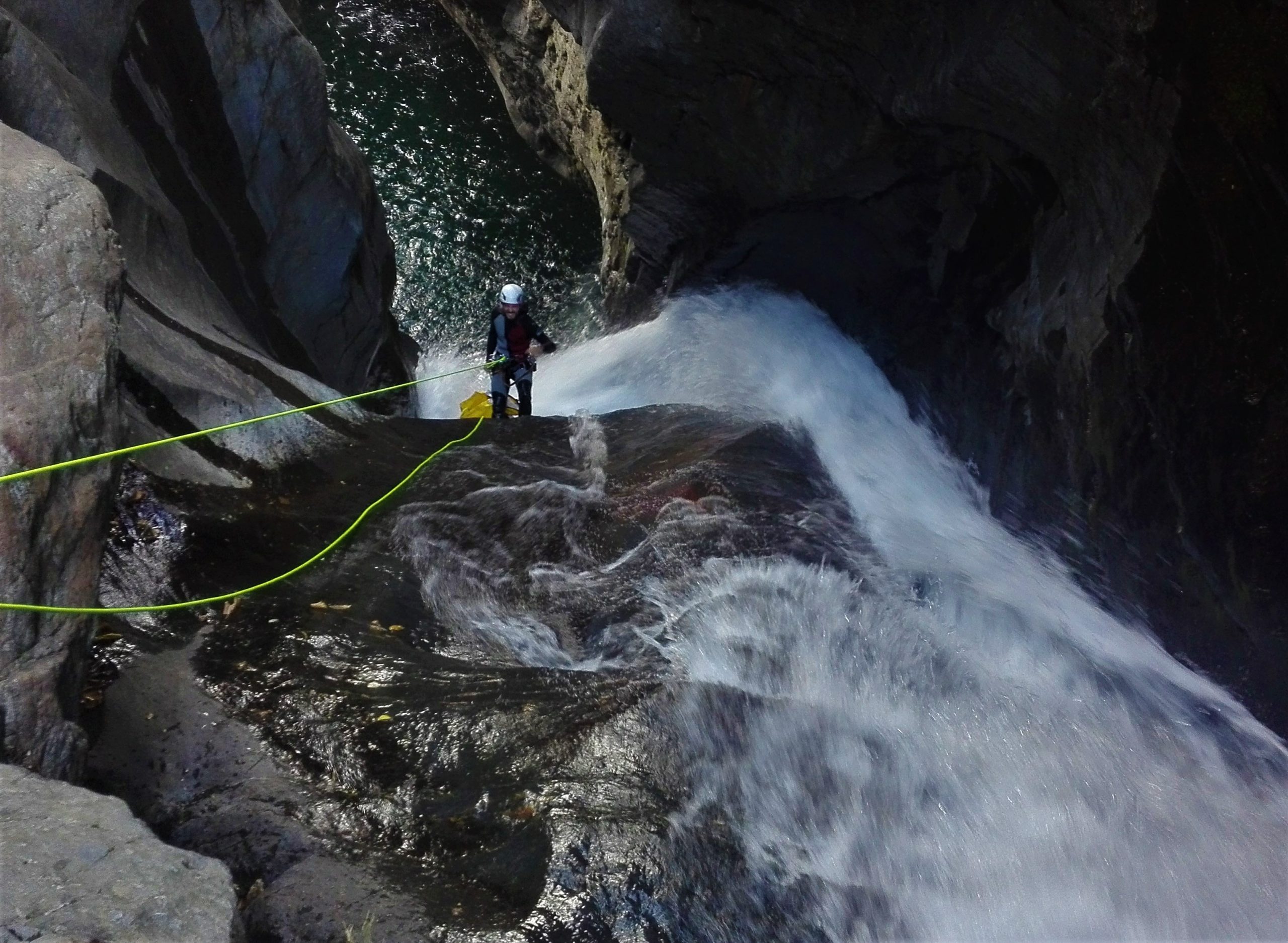Barranco de Eriste Tramo IV
The barranco de Eriste Tramo IV, is one of the most impressive canyons in the entire Pyrenees mountain range. The canyon descends from the high peaks and has quite a large watershed. There are four sections, or tramos. They are so long that it would be a real stretch to try to do all four in one day. The four sections are not continuous, section 1 doesn't end at the beginning of section 2. So it's necessary to hike for extended time between the sections. Therefore, usually people just do one section in a day. Occasionally you can combine two sections into a long day. In this blog entry and video we describe section IV, which is the last section.
Eriste canyon is an advanced descent. It can be quite dangerous because of the large watershed and several narrow passages within the canyon. The dangers escalate with increases in water flow. In conditions of very high water flow it's best to not enter at all because there are several sections of the canyon that pose serious risks. The consequences would be catastrophic. However, with low to medium water flow, this is a real treat to the advanced canyoneer and should definitely be on their ticklist.
Features
This canyon has just about every type of feature that you can find while descending a canyon for recreational purposes. There are several narrow passages, plenty of long pools to swim through, and several other areas with horizontal progression. Hiking through the stream as it opens up and moving carefully over rocks and boulders. But this canyon is most famous for it's intricate rappels, jumps into deep pools, and it's 25m slide!
Slides
There are two spectacular slides. The first you will encounter is about 8m high. This is a nice length for a slide. It isn't for the faint of heart though. It's difficult to get situated at the top because the main current of water goes right where you need to sit. Slowly edge in here because you want to be in a good position before you start. If you get sucked in at the beginning you will be off balance while entering into the slide and this will complicate the situation.
Once you sit down and maintain your balance, resist the force of the water pushing you down. Once you are ready, then you must prepare yourself quickly because the water will take you away once you relax your grip. At first you move left for a few meters before being redirected to the right as you follow the natural course of the rock as it plunges below into a deep pool. The whole sequence is over in about two seconds but those are two long seconds as you ponder the what if's in mid-flight.
The force of the water in the reception pool is also an important factor to take into consideration. You will be tossed and turned in the pool as you enter. If feels like you're in a washing machine. It's a very similar feeling to getting tossed around in the ocean waves while surfing. Just relax and let the water tumble you around and then you pop up unharmed with an easy escape swim into calmer deep water. It's a beauty of a slide and if the conditions are right you should definitely try it. If not, then it's easy to avoid by scrambling and down climbing to the orographic left.
The 25m Slide
Now, on to the main feature of the whole canyon. The 25m slide! This is probably the longest clean slide in any canyon in the Pyrenees. It is quite intimidating from the top. As you approach you can see that there is a drop off coming which usually means a rappel. However, as you get closer you start to see the incline of the drop and at about 45º this slide is the perfect angle. The length is what causes some to back off and look for an alternative route down. It's avoidable by some scrambling and down climbing to the orographic right.
However, if you decide to do this slide, it will be like nothing you've ever done before! It's long and smooth and it drops you into a deep pool. Even though it may seem overwhelming from the top, as you enter it and go down you realize that it is most likely the longest slide you've ever been in. Usually when you enter into a slide you can judge when you're about to enter into the pool. At that point you take a deep breath and go under.
When to Breath
This slide is different. It's so long that you don't know when to take that deep breath. Plus, there's a lot of water coming down this slide and it's bouncing off the rock to the left and to the right. So when you do take your deep breath you can get a mouth full of water. Either way, all this adds to the excitement of such a long natural clean slide in the mountains. The reception pool is deep and large. This allows for an easy swim away from the reception point where all the water is tumbling into the pool. Swim across the large pool and enjoy the views of the slide as you look back and watch your friends go down.
El Rulo
One of the most impressive rappels is also near the end of the canyon. It's called el rulo and it's found in a steep narrow section of the canyon. It's a twisting stream of water that bashes off of one wall and cascades in the air over to the other wall of the canyon. It's quite a unique feature not seen in many other canyons in the world. The trick is to rappel under the stream of water. To do so, it's better to slide down the wall on your butt or your hip, almost like doing a slide, except that you control your descent while rappelling.
It truly is an incredible rappel. The end of the rappel leaves you at the base of the wall and in a deep pool. This part is actually pretty tranquil but now you have to swim out and pass through the powerful stream of water that is bouncing off the rock above. Once through this part it's an easy swim to the end of the pool. There are some tricky water currents in this pool so be careful not to get pushed into the side wall of the pool from the force of the waterfall.
In most of the reception pools in this canyon there are complicated water movements. Reception pools are the areas of water found after jumps, slides, or rappels. This is another reason that this canyon should only be attempted by advanced canyoneers or with a certified canyoning guide, such as Rich at Bigtime Aventura.
Canyoning Trips
If you're an advanced canyoneer and would like to try this canyon, feel free to contact us anytime. There are hundreds of other canyons in the Pyrenees. Take a look at our other canyoning trips. Normally, the high season is summer (June-Sept) but depending on conditions canyoning is possible all year round. If you've never done canyoning before, contact us and we will set up a customized canyoning trip just for you. Look forward to seeing you soon in the canyons!

